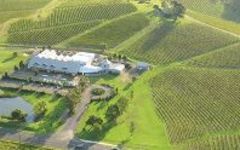Lindeman’s Bin Series Limestone Ridge Shiraz Cabernet 1999
-
Wine
Enthusiast


Product Details
Your Rating
Somm Note
Winemaker Notes
Nose: The bouquet shows intense plum and berry fruit characters with a background of complexed charred American oak.
Palate: The palate has rich, ripe firm peppery fruit flavours with great length and soft lingering tannins.
Professional Ratings
- Wine Enthusiast
Other Vintages
1998-
Wine &
Spirits
-
Wine
Spectator


In 1843, Dr. Lindeman planted his first vineyard on his 330-acre property ‘Cawarra’ in the Hunter Valley of New South Wales. By cellaring wines and not releasing them for sale until they had properly matured, Dr. Lindeman earned a reputation for producing wine of the highest quality. In 1973, the Lindeman’s Winery at Karadoc was built to cater for the increasing consumer demand for Lindeman’s wines around the world. Lindeman’s Bin 65 Chardonnay was first crafted for the Canadian market and launched in 1985 in response to the popularity of the Lindeman’s style of wines in the northern hemisphere.
Following its success in Canada and the United States, Lindeman’s Bin 65 was ‘brought home’ to Australia in 1991. The winemaking team of nine is spread across Victoria and South Australia. Wayne Falkenberg and his team at the Lindeman’s Karadoc Winery produce wines for the Cawarra, Bin Series and Premier Selection labels, whilst the team based in the Coonawarra produce the Reserve and Coonawarra Trio wines.

With hundreds of red grape varieties to choose from, winemakers have the freedom to create a virtually endless assortment of blended red wines. In many European regions, strict laws are in place determining the set of varieties that may be used, but in the New World, experimentation is permitted and encouraged resulting in a wide variety of red wine styles. Blending can be utilized to enhance balance or create complexity, lending different layers of flavors and aromas. For example, a red wine blend variety that creates a fruity and full-bodied wine would do well combined with one that is naturally high in acidity and tannins. Sometimes small amounts of a particular variety are added to boost color or aromatics. Blending can take place before or after fermentation, with the latter, more popular option giving more control to the winemaker over the final qualities of the wine.
How to Serve Red Wine
A common piece of advice is to serve red wine at “room temperature,” but this suggestion is imprecise. After all, room temperature in January is likely to be quite different than in August, even considering the possible effect of central heating and air conditioning systems. The proper temperature to aim for is 55° F to 60° F for lighter-bodied reds and 60° F to 65° F for fuller-bodied wines.
How Long Does Red Wine Last?
Once opened and re-corked, a bottle stored in a cool, dark environment (like your fridge) will stay fresh and nicely drinkable for a day or two. There are products available that can extend that period by a couple of days. As for unopened bottles, optimal storage means keeping them on their sides in a moderately humid environment at about 57° F. Red wines stored in this manner will stay good – and possibly improve – for anywhere from one year to multiple decades. Assessing how long to hold on to a bottle is a complicated science. If you are planning long-term storage of your reds, seek the advice of a wine professional.

Distinguished by a thin, subterranean band of crumbled, red clay loam, Coonawarra is a fairly flat, otherwise unobtrusive region with a cool Mediterranean climate, actually not dissimilar to Bordeaux.
In Coonawarra, this unique layer of red clay is called, "terra rossa" and gets its color from iron oxide. The terra rossa soil overlies soft, penetrable limestone, in a continuous area that is part of the Limestone Coast zone of South Australia. This uncommon layering of soils creates a substrate that is both well draining and at the same time, offers good water retention to support vine roots through dry summers.
Not surprisingly, Coonawara experiences great success with the Bordeaux varieties, namely Cabernet Sauvignon and Merlot, but also Shiraz. However Cabernet reigns superior and accounts for half of the Coonawarra harvest each year. Coonawarra Cabernet Sauvignon develops powerful, yet polished tannins, ripe, red berry fruit and often sweet herb or dried mint qualities. The region has an increased focus on the individual expressions of single vineyards.
